
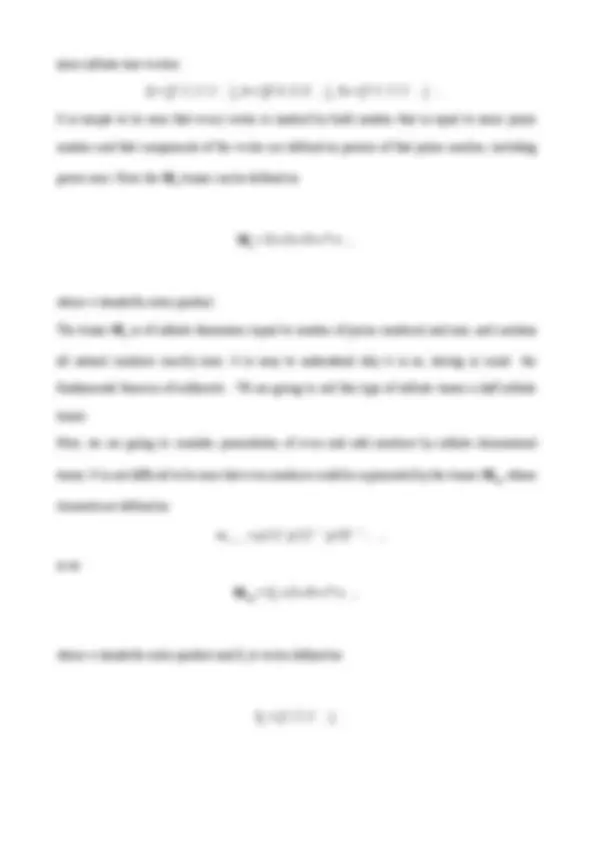
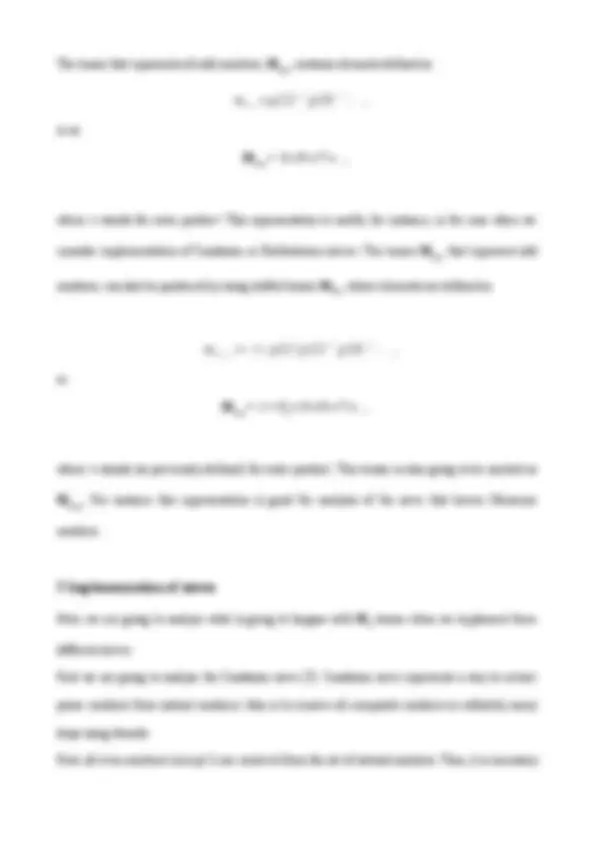

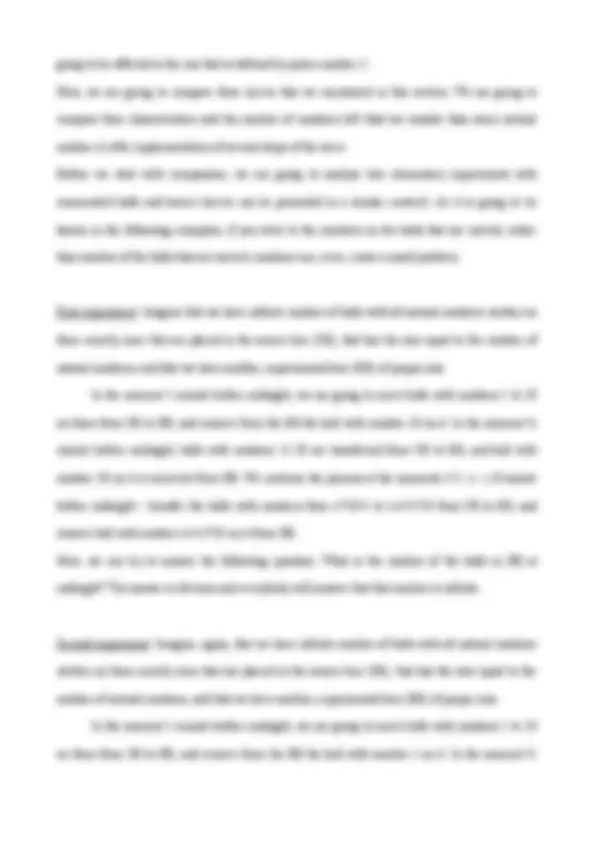
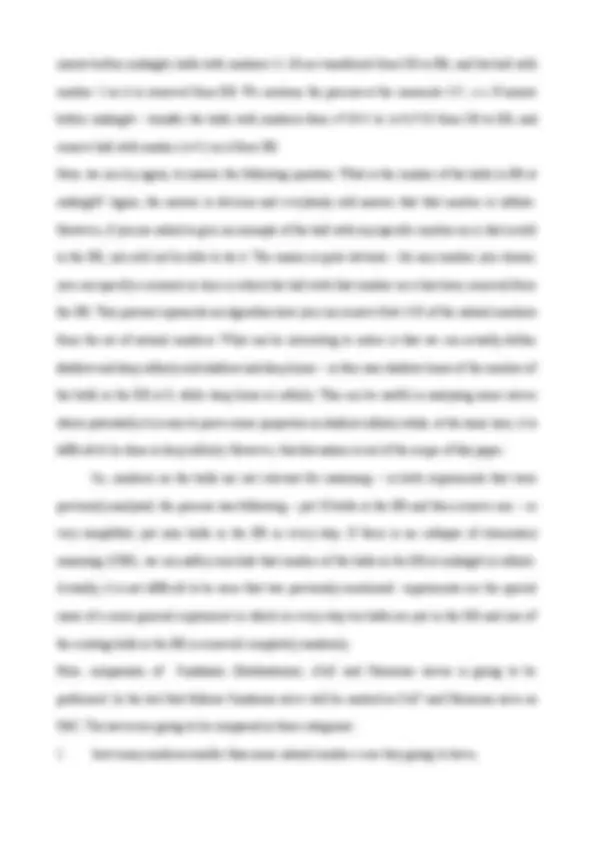
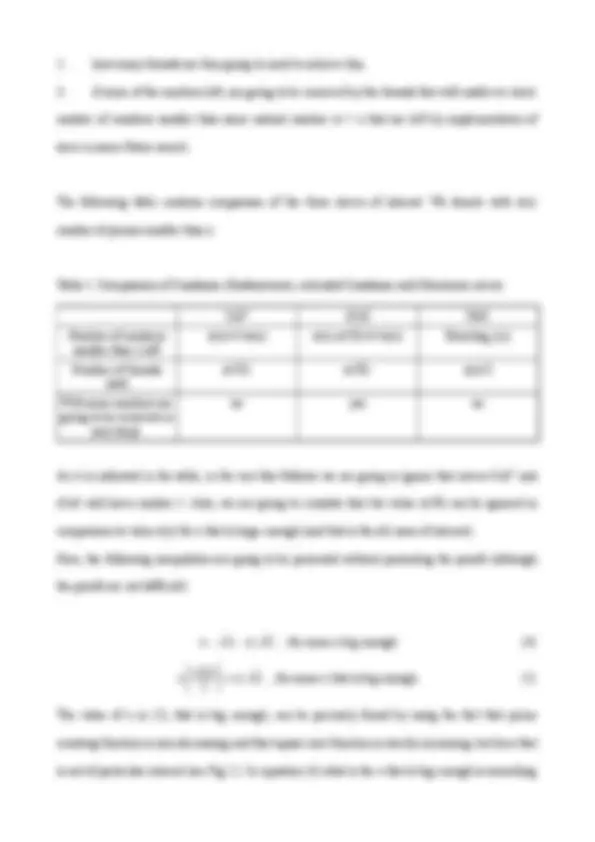
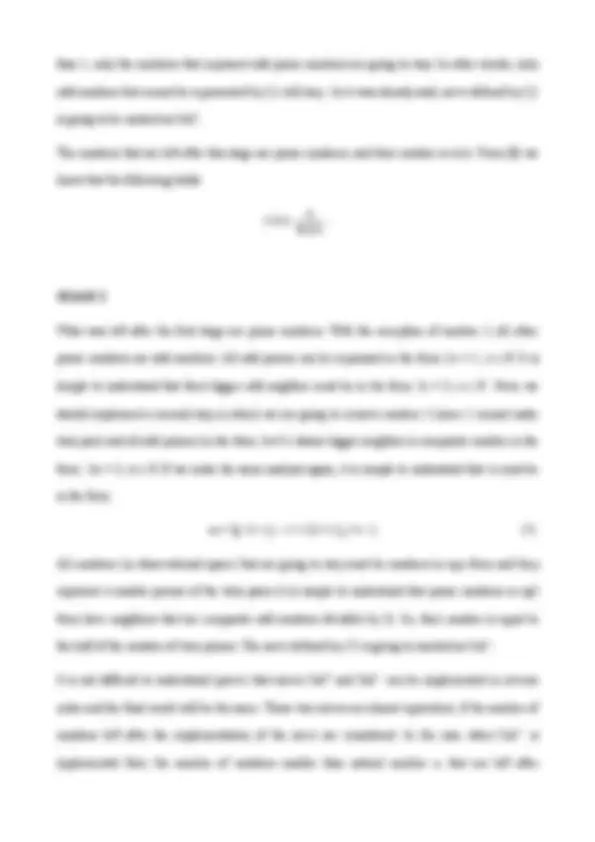

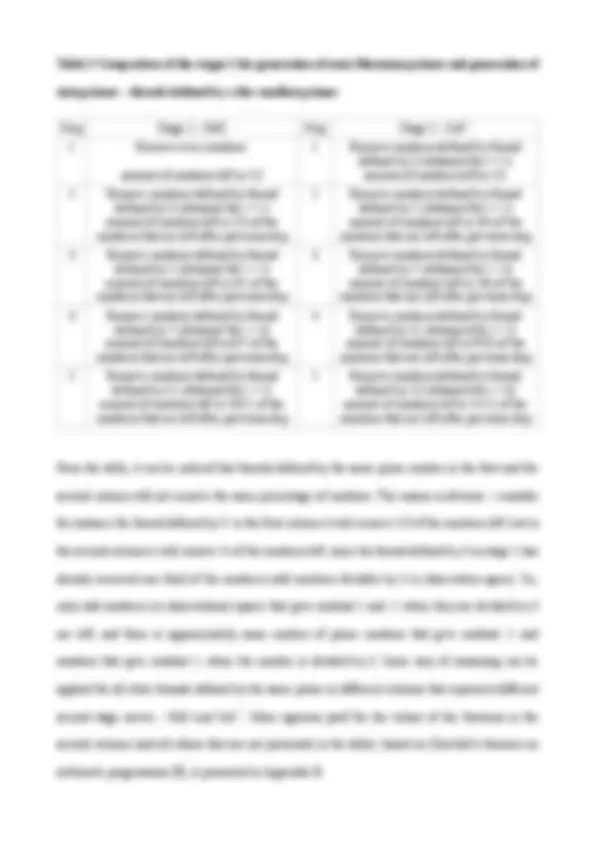
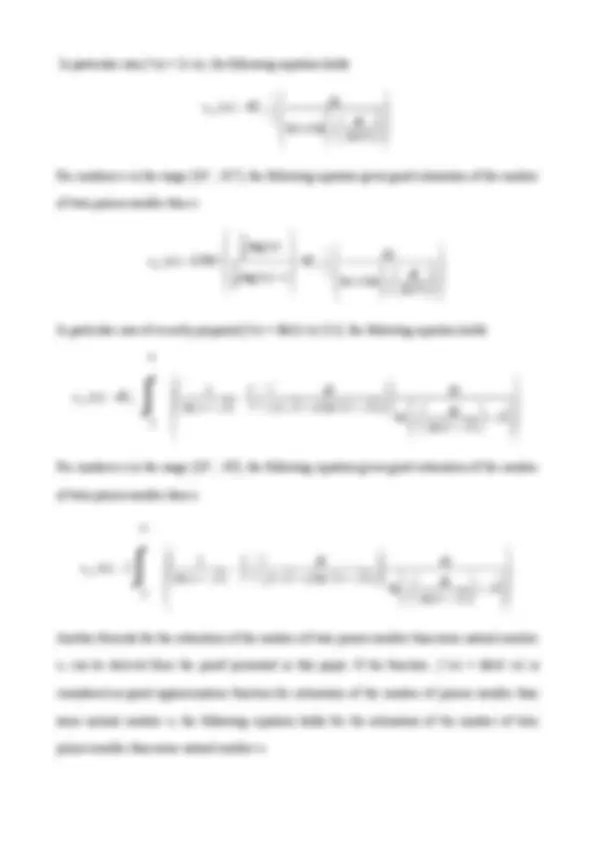
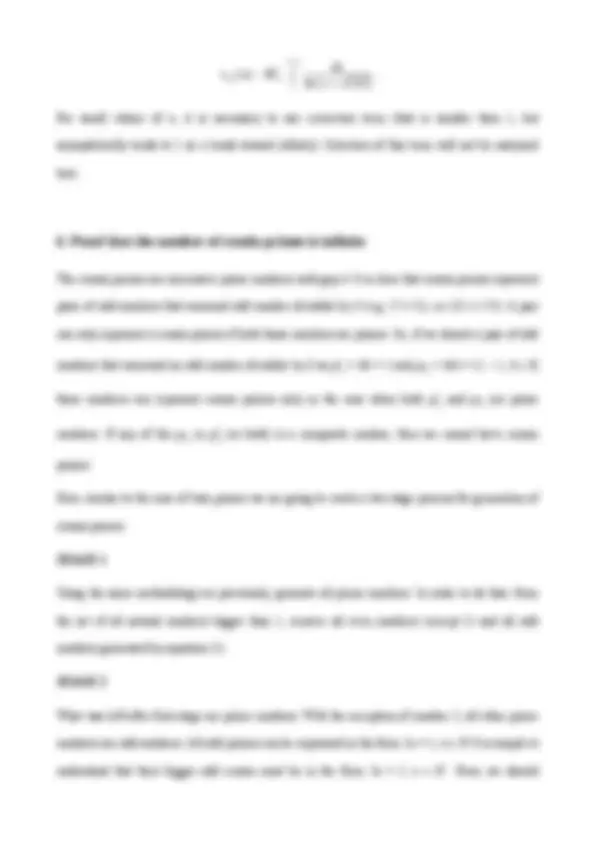
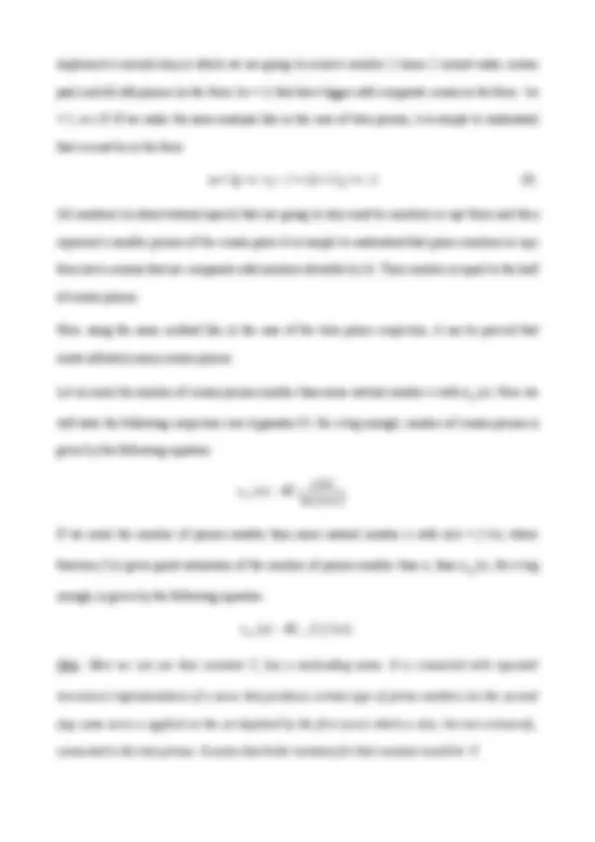
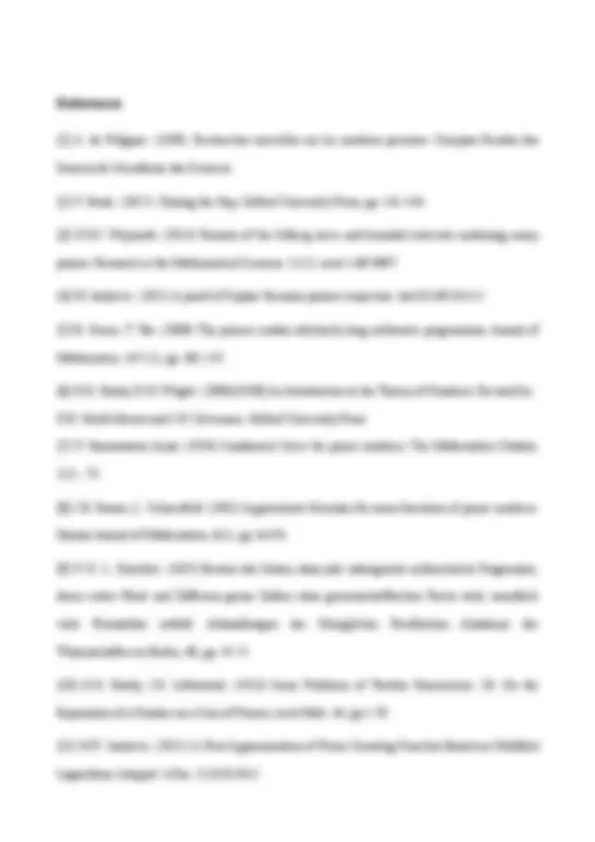

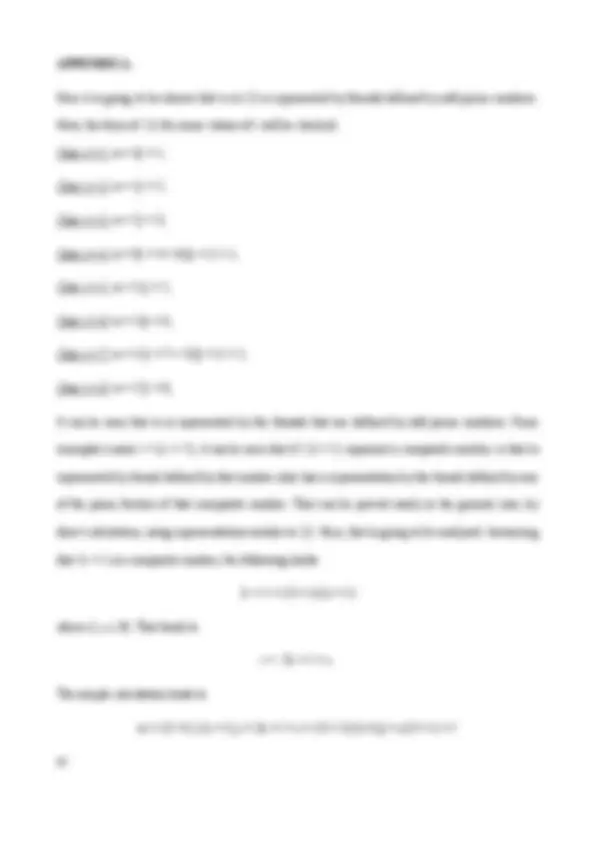
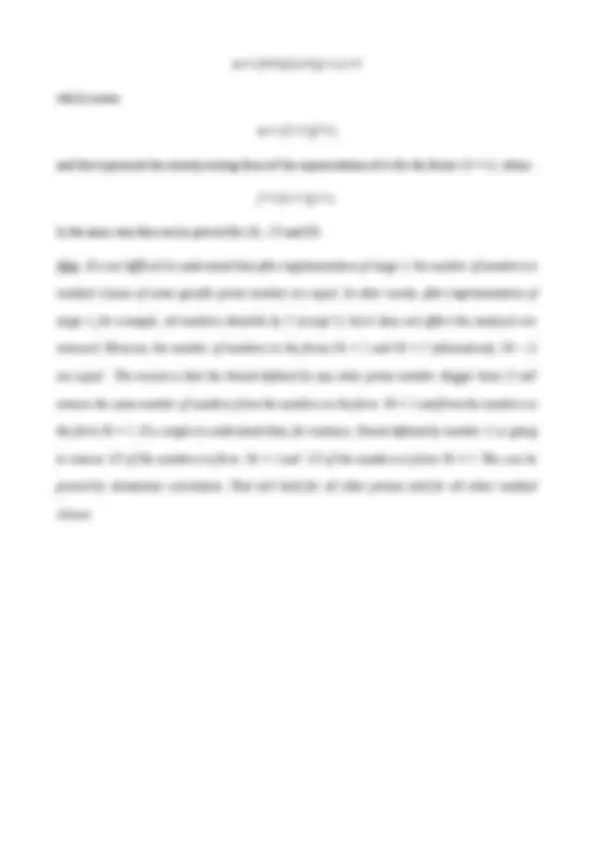
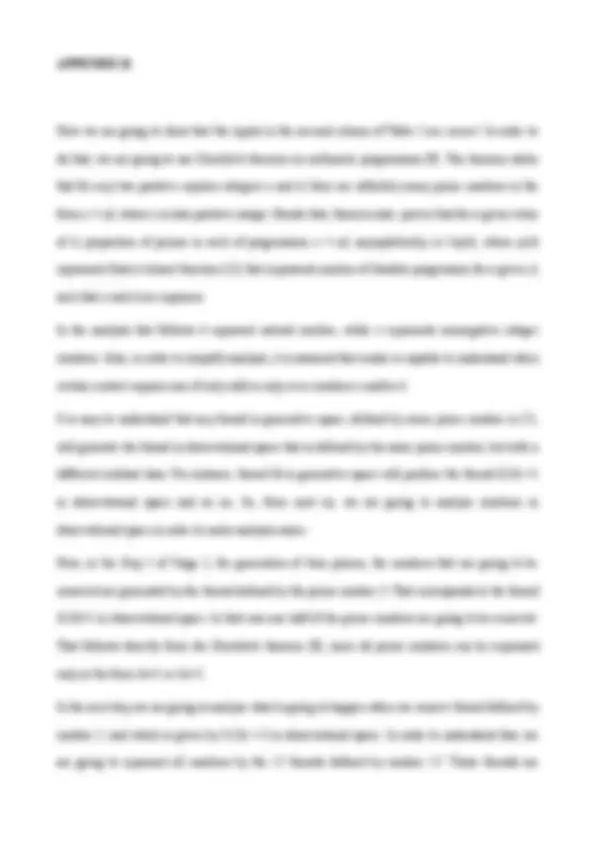

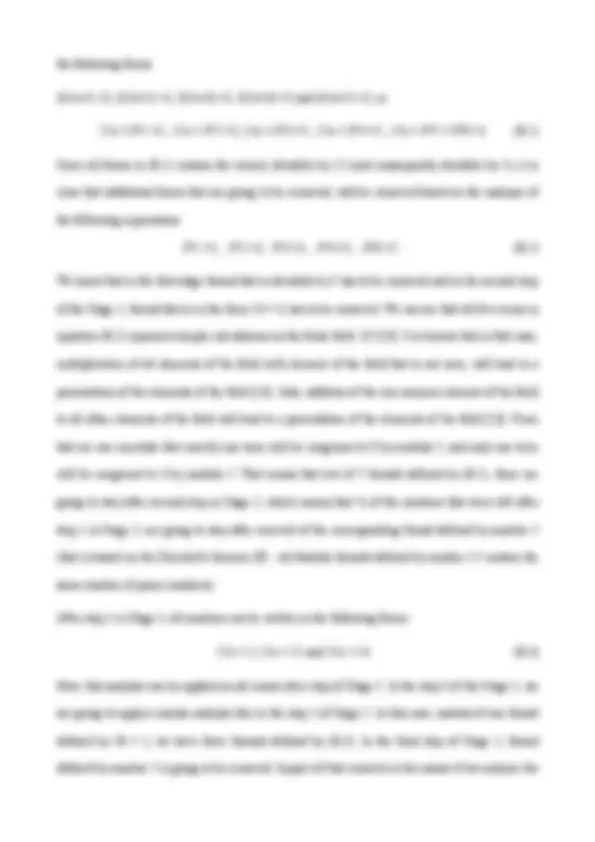
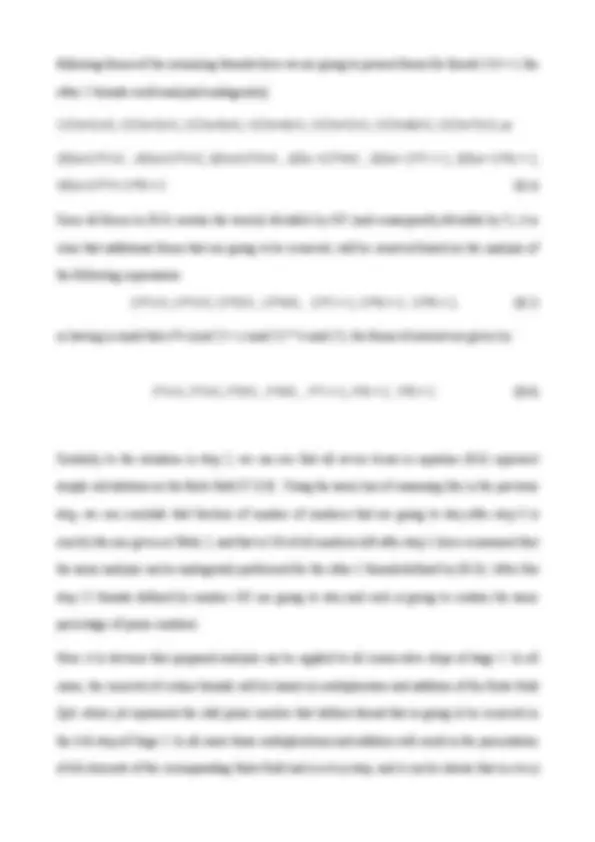

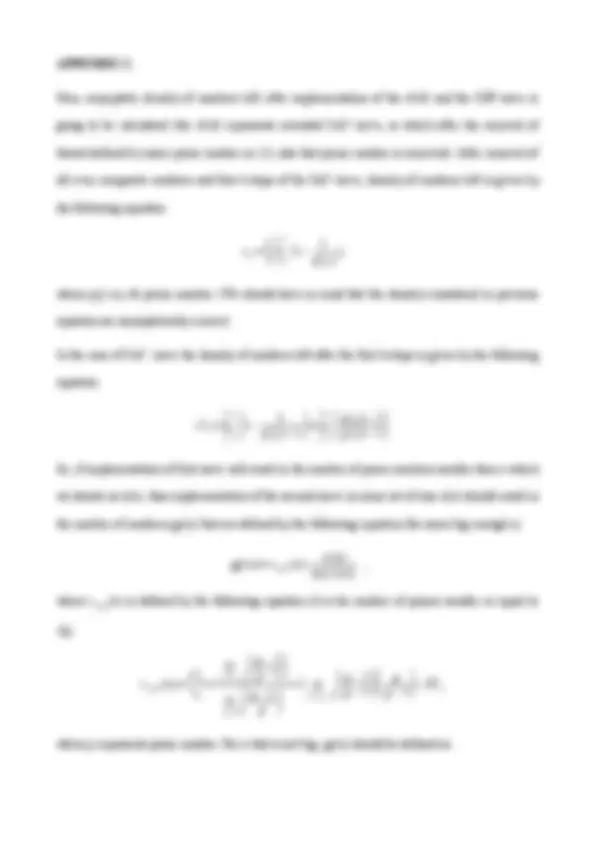



Study with the several resources on Docsity

Earn points by helping other students or get them with a premium plan


Prepare for your exams
Study with the several resources on Docsity

Earn points to download
Earn points by helping other students or get them with a premium plan
Community
Ask the community for help and clear up your study doubts
Discover the best universities in your country according to Docsity users
Free resources
Download our free guides on studying techniques, anxiety management strategies, and thesis advice from Docsity tutors
The Sundaram sieve is a method to extract prime numbers from natural numbers by removing certain numbers from the set of odd natural numbers. two experiments involving infinite balls labeled with natural numbers and the application of the Sundaram sieve. The sieves are compared based on the number of numbers left, the number of threads needed, and the potential impact on future searches. The document also discusses the concept of cousin primes and the percentage of numbers left after each step in Stage 2.
What you will learn
Typology: Study notes
1 / 31

This page cannot be seen from the preview
Don't miss anything!
























Institute of Electrical Engineering “Nikola Tesla”, Belgrade, Serbia to Abstract In this paper proof of the twin prime conjecture is going to be presented. Originally very difficult problem (in observational space) has been transformed into a simpler one (in generative space) that can be solved. It will be shown that twin primes could be obtained through two stage sieve process, and that will be used to show that exist infinite number of twin primes. The same approach is used to prove Polignac's conjecture for cousin primes.
In number theory, Polignac's conjecture states: For any positive even number n, there are infinitely many prime gaps of size n. In other words: there are infinitely many cases of two consecutive prime numbers with the difference n [1]. For n = 2 it is known as twin prime conjecture. The results that were presented in the literature and that are the closest to the solution of the twin prime conjecture are the following:
analyzed directly, but rather their representatives that are used to produce them. It will be shown that twin primes could be generated by two stage recursion type sieve process. This process will be compared to the other two stage sieve process that leaves infinitely many numbers. The fact that sieve process that generate twin primes leaves more numbers than the other sieve process, will be used to prove that infinitely many twin primes exist. In the last part of the paper it will be shown that the number of cousin primes is infinite, too. Without going into the details, here we can say that using a procedure very similar to one proposed in this paper, it is possible to make an elementary proof of Green-Tao theorem [5]. The major difference is that in the case of Green-Tao theorem recursion has the depth that is equal to the length of the arithmetic progression, while the depth of the recursion in the case of twin prime conjecture is 2 (equal to the length of the “arithmetic progression” with two elements). Remark 1: In this paper any infinite series in the form c 1 ·l ± c 2 is going to be called a thread defined by number c 1 (in literature these forms are known as linear factors – however, it seems that the term thread is probably better choice in this context). Here c 1 and c 2 are numbers that belong to the set of natural numbers (c 2 can also be zero and usually is smaller than c 1 ) and l represents an infinite series of consecutive natural numbers in the form (1, 2, 3, …).
The fundamental theorem of arithmetic states that every integer greater than 1 can be uniquely represented by a product of powers of prime numbers, up to the order of the factors [6]. Having that in mind, an infinite dimensional tensor MN that contains all natural numbers only once, is going to be constructed. In order to do that we are going to mark vector that contains all prime numbers with p. So, p(1) = 2, p(2) = 3, p(3) = 5, and so on. Tensor MN with elements mi1 i2 i3 ... is defined by the following equation (i 1 , i 2 , i 3 , … are natural numbers): mi 1 i 2 i 3 ...= p( 1 ) i 1 − 1 p ( 2 ) i 2 − 1 p( 3 ) i 3 − 1 .... The alternative definition is also possible. Now, the following notation is going to be assumed for
The tensor that represents all odd numbers, MNO, contains elements defined as mi 1 i 2 ...= p( 2 ) i 1 − 1 p( 3 ) i 2 − 1 ... , or as MNO = 3 ○ 5 ○ 7 ○..., where ○ stands for outer product. This representation is useful, for instance, in the case when we consider implementation of Sundaram or Erathostenes sieves. The tensor MNO, that represent odd numbers, can also be produced by using shifted tensor MNE, where elements are defined as mi 1 i 2 i 3 ...=− 1 + p( 1 ) i 1 p ( 2 ) i 2 − 1 p ( 3 ) i 3 − 1 ... , or MNO = -1 + (^2) s ○ 3 ○ 5 ○ 7 ○..., where ○ stands (as previously defined) for outer product. This tensor is also going to be marked as MNOS. For instance this representation is good for analysis of the sieve that leaves Mersenne numbers.
Now, we are going to analyze what is going to happen with MN-tensor when we implement three different sieves. First we are going to analyse the Sundaram sieve [7]. Sundaram sieve represents a way to extract prime numbers from natural numbers. Idea is to remove all composite numbers in infinitely many steps using threads. First, all even numbers (except 2) are removed from the set of natural numbers. Then, it is necessary
to remove the composite odd numbers from the rest of the numbers. In order to do that, the formula for the composite odd numbers is going to be analyzed. It is well known that odd numbers bigger than 1, here denoted by a, can be represented by the following formula a = 2n +1, where n ϵ N. It is not difficult to prove that all composite odd numbers ac can be represented by the following formula ac= 2 ( 2 i j+i+ j)+ 1 = 2 (( 2 j+ 1 )i+ j )+1. (1) where i, j ϵ N. It is simple to conclude that all composite numbers could be represented by product (i + 1)(j + 1), where i, j ϵ N. If it is checked how that formula looks like for the odd numbers, after simple calculation, equation (1) is obtained. This calculation is presented here. The form 2m + 1, m ϵ N will represent odd numbers that are composite. Then the following equation holds 2 m+ 1 =( 2 i+ 1 )( 2 j+ 1 ) , where i, j ϵ N. Now, it is easy to see that the following equation holds m = 2ij + i + j = (2i + 1) j + i. (2) When all numbers represented by m are removed from the set of odd natural numbers bigger than 1, only the numbers that represent odd prime numbers are going to stay. In other words, only odd numbers that cannot be represented by (1) will stay. In order to understand the process, a 3D tensor of infinite size, that contains all natural numbers that could be defined by the first 3 primes – 2, 3 and 5 (any three primes could be chosen – it does not change the line of reasoning). That tensor represents 3D sub-tensor of MN-tensor. Here we are going to illustrate the frontal, lateral and top slice of this tensor. The frontal, top and lateral slices of the tensor are represented by infinite size 2D matrices given as
tensor is going to collapse to one element that contains prime number that defines the corresponding thread and that dimension of the tensor. All other elements along that dimension are empty (the empty elements are introduced in order to have reasonable tensor representation). At the end of the process we are going to have 2x2x2 tensor that have only 4 elements that are non-empty. One is top, left corner that is filled by 1, and 3 of his neighbors along the orthogonal dimensions that are filled with first three prime numbers. All other elements (4 in total) are empty. In general case only those elements of the tensor that are going to be nonempty after implementation of full Sundaram sieve, are given by the following equation (tensor will have 2x2x2x … dimension) m1 1 1...= 1 ; m1 2 1 11... = p ( 1 ); m1 1 2 1 1...= p( 2 ); m1 1 1 2 1...= p( 3 ); ... m11 1 ...2 (on position k+ 1 )1 1...= p(k ); .... The second sieve that is going to be considered is a sieve that is obtained by simple extension of Sundaram sieve – when you remove one thread defined by some prime number, you also remove a prime number that defines that thread. We will call this sieve extended Sundaram sieve or eSuS sieve. The third sieve of interest is sieve that is the one which we are going to call Mersenne sieve. In this sieve, in first step all even numbers are removed. Then, from the odd numbers are removed the threads defined by the following equation: ai= 2 p(i) j− 1, i=2,3, 4,... (3) where j ϵ N. It is not difficult to be seen that only numbers that are going to be left are Mersenne numbers, or numbers in the form a= 2 i − 1, i=1, 2,3, ... This can be easily concluded from the MNOS representation of odd numbers – removal of individual threads causes the collapse of the MNOS tensor along that dimension, and only dimension that is not
going to be affected is the one that is defined by prime number 2. Now, we are going to compare three sieves that we mentioned in this section. We are going to compare their characteristics and the number of numbers left (that are smaller than some natural number n) after implementation of several steps of the sieve. Before we start with comparison, we are going to analyse two elementary experiments with enumerated balls and boxes (sieves can be presented in a similar context). As it is going to be shown in the following examples, if you stick to the numbers on the balls that are moved, rather than number of the balls that are moved, numbers can, even, create a small problem. First experiment: Imagine that we have infinite number of balls with all natural numbers written on them exactly once that are placed in the source box (SB), that has the size equal to the number of natural numbers, and that we have another, experimental box (EB) of proper size. In the moment 1 minute before midnight, we are going to move balls with numbers 1 to 10 on them from SB to EB, and remove from the EB the ball with number 10 on it. In the moment ½ minute before midnight, balls with numbers 11-20 are transferred from SB to EB, and ball with number 20 on it is removed from EB. We continue the process at the moments 1/2n, n ϵ N minute before midnight – transfer the balls with numbers form n10+1 to (n+1)10 from SB to EB, and remove ball with number (n+1)*10 on it from EB. Now, we can try to answer the following question: What is the number of the balls in EB at midnight? The answer is obvious and everybody will answer that that number is infinite. Second experiment: Imagine, again, that we have infinite number of balls with all natural numbers written on them exactly once that are placed in the source box (SB), that has the size equal to the number of natural numbers, and that we have another, experimental box (EB) of proper size. In the moment 1 minute before midnight, we are going to move balls with numbers 1 to 10 on them from SB to EB, and remove from the EB the ball with number 1 on it. In the moment ½
π(√n) , for some n that is big enough. (5) The value of n in (5), that is big enough, can be precisely found by using the fact that prime counting function is non-decreasing and that square root function is strictly increasing, but here that is not of particular interest (see Fig 2.). In equation (4) what is the n that is big enough is something
that is defined by the context in which inequality is used. Fig. 2. Comparison of the number of threads required for the realization of the MeS and SuS-1^ sieves for generation of semi Mersenne primes (SMP) and twin primes (TWP) numbers smaller than some natural number n Here, an additional difference between SuS^0 and MeS on one side and eSuS on the other side is going to be stressed. It is not difficult to be understood that after infinite number of steps, or removal of infinite number of threads, we are not going to be able to specify a single number left by eSuS although the number of numbers left is infinite. This is another example in which limes in shallow infinity is zero and limes in deep infinity is infinite. For SuS^0 and MeS both shallow and deep infinity limeses are infinite. Also one more thing is worth noticing: SuS^0 will leave infinitely more numbers left than the eSuS (every thread leaves one number more), however that infinite difference is very small comparing to the overall number of numbers left (asymptotically the ratio of those two numbers is zero).
than 1, only the numbers that represent odd prime numbers are going to stay. In other words, only odd numbers that cannot be represented by (1) will stay. As it was already said, sieve defined by (2) is going to be marked as SuS^0. The numbers that are left after this stage are prime numbers, and their number is π(n). From [8] we know that the following holds π(n)≈ n
What was left after the first stage are prime numbers. With the exception of number 2, all other prime numbers are odd numbers. All odd primes can be expressed in the form 2n + 1, n ϵ N. It is simple to understand that their bigger odd neighbor must be in the form 2n + 3, n ϵ N. Now, we should implement a second step in which we are going to remove number 2 (since 2 cannot make twin pair) and all odd primes (in the form 2m+1) whose bigger neighbor is composite number in the form 2m + 3, m ϵ N. If we make the same analysis again, it is simple to understand that m must be in the form m = 2ij + i + j – 1 = (2i + 1) j + i -1. (7) All numbers (in observational space) that are going to stay must be numbers in mps form and they represent a smaller primes of the twin pairs (it is simple to understand that prime numbers in mpl form have neighbors that are composite odd numbers divisible by 3). So, their number is equal to the half of the number of twin primes. The sieve defined by (7) is going to marked as SuS-1. It is not difficult to understand (prove) that sieves SuS^0 and SuS-1^ can be implemented in reverse order and the final result will be the same. Those two sieves are almost equivalent, if the number of numbers left after the implementation of the sieve are considered. In the case when SuS-1^ is implemented first, the number of numbers smaller than natural number n, that are left after
implementation of sieve is going to be marked as π-1(n). It is very simple to prove that the following equation holds π(n) – π-1(n) ≤ 1. Let us mark the number of twin primes with πG2. Also, let us define the number of numbers that is left after consecutive implementations of Sundaram sieve, SuS^0 , and Mersenne sieve, MeS, as pSMP. The numbers obtained after implementation of those sieves are going to be called semi Merssenne primes, or SMP. The second stage MeS sieve is applied on prime number indexes. In that case it is easy to understand that the following equation would hold (n ϵ N) pSMP (n)= floor (log 2 (π(n))) , (8) where pSMP(n) represents the number of SMP smaller than some natural number n. Since the twin primes are obtained by implementation of the SuS^0 in the first stage and sieve that is similar to it, SuS-1^ in the second stage, it is not difficult to conclude that numbers πG2 is bigger than the pSMP. In order to understand why it is so, we are going to analyze (3) and (7) in more detail. It is not difficult to be seen that m in (3) and (7) is represented by the threads that are defined by odd prime numbers. For details see Appendix A. Now we are going to compare sieves SuS-1^ and MeS step by step, for a few initial steps (analysis can be easily extended to any number of steps). Removal of number 2 in the second stage of SuS-1^ is ignored. What we would like to say is that the values of the fractions presented in the table are asymptotically correct, but in the finite case they are only approximately correct.
From Table 2 can be seen that in every step, except step 1, threads in the second column will leave bigger percentage of numbers than the corresponding threads in the first column. This could be easily understood form the analysis that follows:
p (i)− 2 p (i )− 1
From Table 2 (or last equation) we can see that bigger number of numbers is left in every step of stage 2 then in the stage 1 (except 1st^ step). From that, we can conclude that after every step bigger than 1, part of the numbers that is left in stage 2 after implementation of SuS-1^ is bigger than the number of numbers left in the stage 2 after implementation of MeS (that is also true if we consider amount of numbers left after removal of all numbers generated by threads that are defined by all prime numbers smaller than some natural number). Having in mind previous analysis, it can be safely concluded that the following equation holds πG 2
pSMP = lim n → ∞ pSMP (n).
From previous inequality it can be concluded that the following equation must hold πG2 > pSMP= lim n → ∞ pSMP (n). Having in mind (8), and since it it easy to show that following holds lim n → ∞ log 2 (π(n))=∞ , then it is easy to understand that the following equation holds pSMP = lim n → ∞ pSMP (n)=∞. Now, we can safely conclude that the number of twin primes is infinite. That concludes the proof.
Here we will state the following conjecture: for n big enough, number of twin primes smaller than some natural number n, marked as πG2(n) is given by the following equation πG2 (n) ∼ 4 C 2 π(π(n))≈ 4 C 2 π (n)
where C 2 represents the twin prime constant [10]. Why it is reasonable to make such conjecture is explained in Appendix C. More precisely, instead of value π (π(n)) in the previous formula should stay value π(π(n))-π(√π(n))+1. However, based on the discussion after the Table 1, for n big enough value -π (√π(n))+1 can be ignored. If we mark the number of primes smaller than some natural number n with π(n) ≈ f (n), where function f (n) gives good estimation of the number of primes smaller than n, than πG2(n), for n big enough, is given by the following equation πG2 (n) ∼ 4C 2 ⋅ f ( f (n)).
2 π(n) dx ln (x+√π(n))
For small values of n, it is necessary to use correction term (that is smaller than 1, but asymptotically tends to 1 as n tends toward infinity). Selection of this term will not be analyzed here.
The cousin primes are successive prime numbers with gap 4. It is clear that cousin primes represent pairs of odd numbers that surround odd number divisible by 3 (e.g. (7 9 11), or (13 15 17)). A pair can only represent a cousin primes if both those numbers are primes. So, if we denote a pair of odd numbers that surround an odd number divisible by 3 as plk = 6k + 1 and psk = 6(k + 1) – 1, k ϵ N, these numbers can represent cousin primes only in the case when both plk and psk are prime numbers. If any of the psk or plk (or both) is a composite number, then we cannot have cousin primes. Here, similar to the case of twin primes we are going to create a two stage process for generation of cousin primes. STAGE 1 Using the same methodology as previously, generate all prime numbers. In order to do that, from the set of all natural numbers bigger than 1, remove all even numbers (except 2) and all odd numbers generated by equation (2). STAGE 2 What was left after first stage are prime numbers. With the exception of number 2, all other prime numbers are odd numbers. All odd primes can be expressed in the form 2n + 1, n ϵ N. It is simple to understand that their bigger odd cousin must be in the form 2n + 5, n ϵ N. Now, we should
implement a second step in which we are going to remove number 2 (since 2 cannot make cousin pair) and all odd primes (in the form 2m + 1) that have bigger odd composite cousin in the form 2m
If we mark the number of primes smaller than some natural number n with π(n) ≈ f (n), where function f (n) gives good estimation of the number of primes smaller than n, than πG4(n), for n big enough, is given by the following equation πG4 (n) ∼ 4C 2 ⋅ f ( f (n)). Note: Here we can see that constant C 2 has a misleading name. It is connected with repeated (recursive) implementation of a sieve that produces certain type of prime numbers (in the second step same sieve is applied on the set depleted by the first sieve) which is also, but not exclusively, connected to the twin primes. It seems that better notation for that constant would be 2 S.